Adam Osterholzer: adam.osterholzer@colostate.edu, 970-222-9568
Dr. Punya Nachappa: Punya.Nachappa@colostate.edu, 785-383-4873
Visit our website at: https://www.csuwheatentomology.com/.
October 3, 2025
Statewide wheat stem sawfly (WSS) survey
To assess the spread and severity of Colorado wheat stem sawfly (WSS) infestation, a statewide survey has been conducted annually since 2013. The sites are selected based on wheat acreage per county, proximity to the previous year’s wheat stubble, and a minimum distance of 10 miles from other survey sites. At each site, 100 wheat tillers are dissected to determine the presence of WSS larvae. Infestation levels are classified as follows:
- Low: <10% of tillers infested
- Medium: 10%–50% of tillers infested
- High: >50% of tillers infested
From 2013 through 2025, survey data indicated an increase in the proportion of infested sites. This included a notable rise in locations with medium and high infestation levels (Table 1).
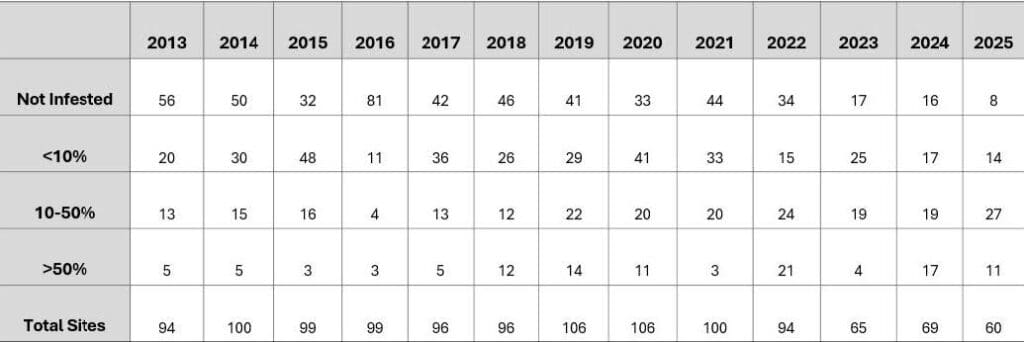
Table 1: Number of CO wheat fields in each infestation category from 2013 to 2025.
In 2025, populations remained relatively unchanged, with most counties experiencing only minor changes in infestation levels (Figure 2). However, Sedgwick, Lincoln, and Phillips counties saw significant increases in infestation, while Washington County experienced a decrease (Table 2). The average infestation rate for the entire state was 25.4%, which is a small decrease from 27.4% in 2024.
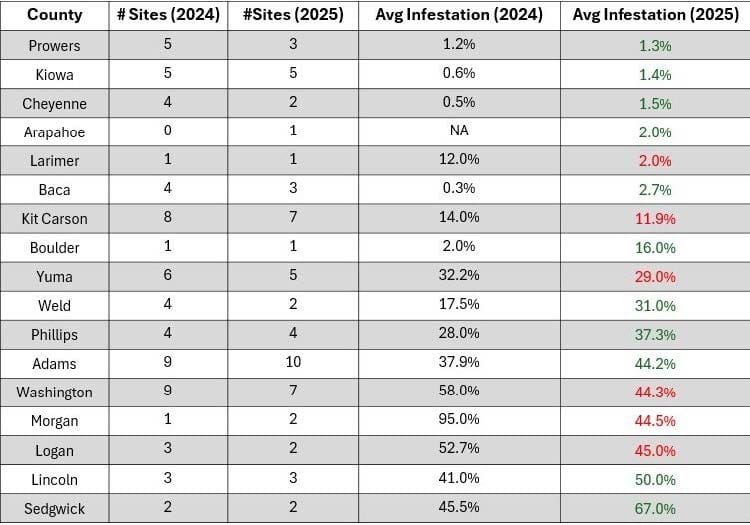
Table 2: Colorado survey sites and infestation averages per county in 2024 and 2025.

Figure 2: Heat maps comparing Colorado WSS infestation in 2024 and 2025.
Statewide Bracon parasitoid survey
Bracon parasitoid wasps, which lay their eggs on the larva of the sawfly causing the death of these hosts, were detected in several locations for the first time in 2025 (Figure 3). In previous state-wide surveys, we did not find these parasitoids in significant numbers. While this development is encouraging, conservation efforts are essential to help these populations sustain and grow. The “Beneficial Bug Baler” project, funded by Colorado Wheat Royalty Funds (CWRF) and USDA-ARS, aims to support the natural Bracon parasitoid populations.
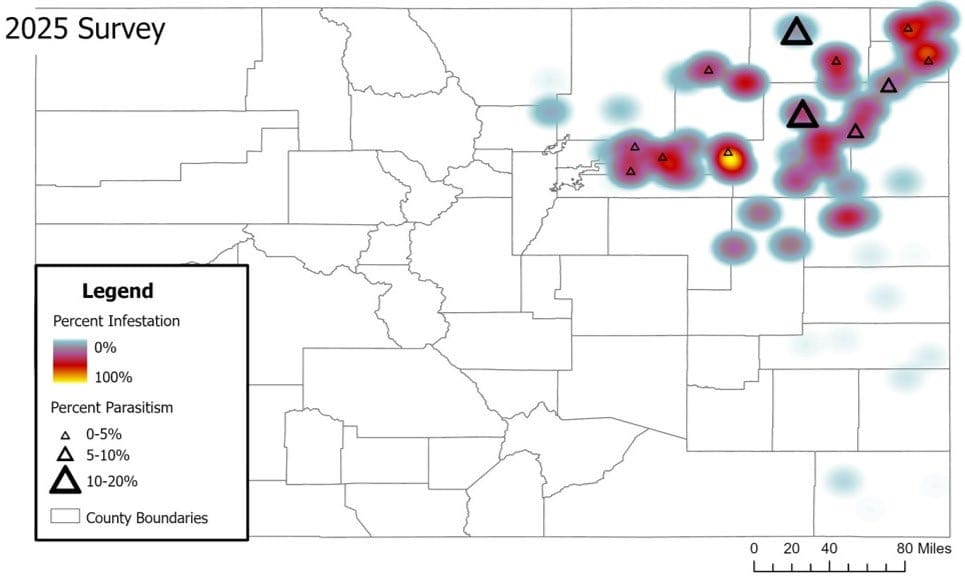
Figure 3: Map depicting 2025 Colorado WSS infestation and Bracon parasitism. Parasitism percentages were calculated as number of Bracon divided by number of WSS infested stems per site.
Kansas wheat stem sawfly survey
In Kansas, similar to the Colorado survey, we dissected 100 tillers at each site to identify the presence of WSS larvae. Infestation levels were classified using the same criteria as in the Colorado survey. In the past, Kansas had low to no-infestation; however, infestation has been increasing since 2024.
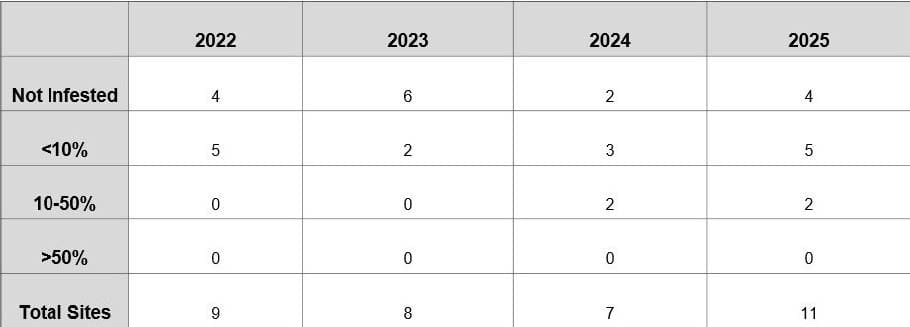
Table 3: Number of KS wheat fields in each infestation category from 2022 to 2025.
While the 2025 average statewide infestation decreased from 11.8% to 5.5%, this is largely due to a larger sample size for Rawlins county and no suitable wheat fields were found in Wallace and Decatur counties (Figure 4, Table 4). Farmers in these regions are encouraged to scout their fields regularly and plant semi-solid varieties as needed.

Table 4: KS survey sites and infestation averages per county in 2024 and 2025.

Figure 4: Maps depicting Kansas WSS infestation in 2024 and 2025. Note: a different scale (0-25%) used to represent WSS infestation compared to Colorado (0-100%).
Acknowledgements
We would like to acknowledge the funding from the Colorado Wheat Administrative Committee, which supports undergraduate student helpers and travel to field sites.
June 23, 2025
Aphid and leafhopper outbreaks
While the wheat stem sawfly remains the predominant pest of concern in Colorado wheat production, we have observed increased populations of cereal aphids and leafhoppers this year. Several cereal aphids are important vectors of plant diseases such as bird-cherry oat aphids that causes barley yellow dwarf disease (BYDV). We are working with Dr. Robyn Roberts to confirm the presence of BYDV in symptomatic plants. We did not observe any wheat curl mites in these plants, but Dr. Roberts’s lab is testing for the presence of wheat streak mosaic virus, triticum mosaic virus and High Plains wheat mosaic virus. If you observe unusual or concerning insect activity in your fields, please don’t hesitate to contact us.
Aphid Identification
Bird cherry-oat aphid (Rhopalosiphum padi): The insect is 1/16 inch long, olive-green colored with a red-orange patch surrounding the base of the body (Figure 1). Most of the aphids we found were bird cherry-oat aphids. Populations were observed in Burlington, Byers, Julesburg, and New Raymer. This insect is a known vector of barley yellow dwarf virus (BYDV), which causes leaf discoloration and diminished plant growth.
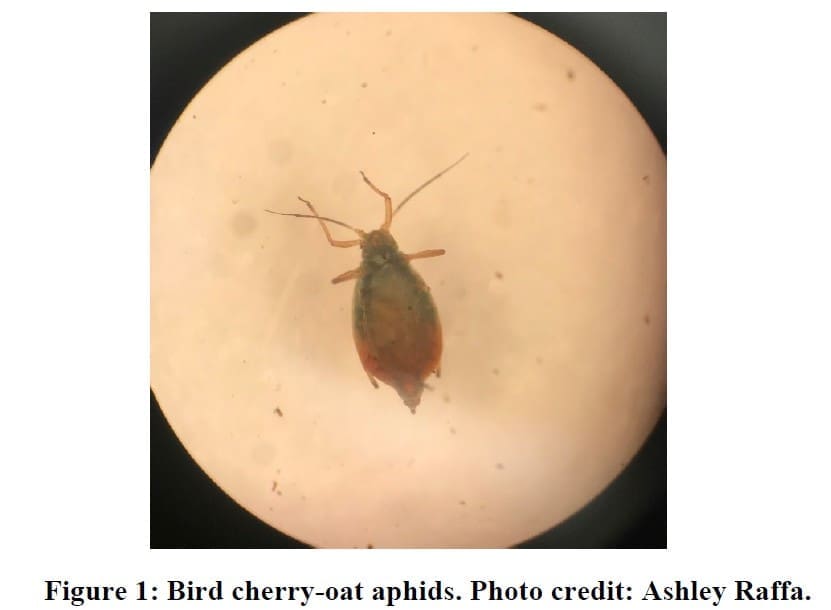
Russian wheat aphid (Diruaphis noxia): This aphid is about 1/16 inch long, lime green in color and “spindle shaped” (Figure 2). This aphid is a historically troublesome pest of Colorado wheat crops. Although it has rarely reached treatment thresholds in recent years, confirmed populations have been found in Byers and New Raymer. Leaves infested by Russian wheat aphids have long white, purple or yellowish streaks.. The grain heads will often have a “fishhook” appearance, which results from the awns becoming trapped in curled leaves. Thankfully, the Russian wheat aphid is not a vector of virus diseases!
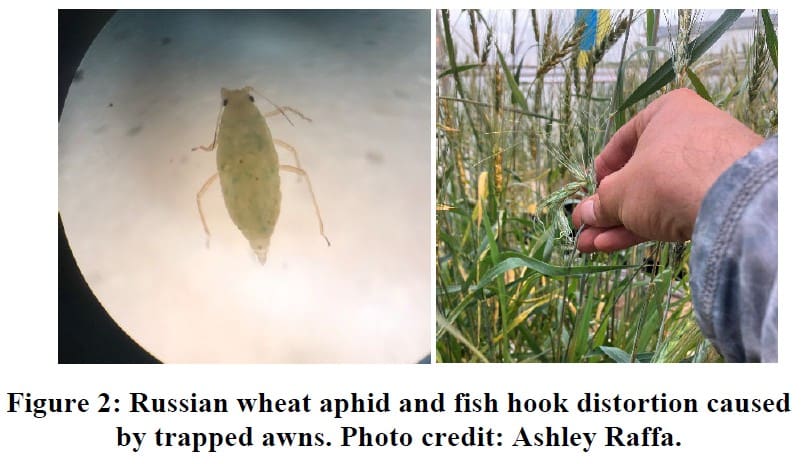
Greenbug (Schizaphis graminum): These aphids are also 1/16 inch long with an oval-shaped, light green body and a darker green stripe down its back (Figure 3). It is a known vector of BYDV and also injects toxins while feeding (Peairs, 2016). It has been confirmed at Byers and New Raymer. We will continue to monitor for populations at different locations throughout the state. Damage from greenbug feeding first appears as tiny reddish or copper colored spots on leaves. As greenbugs continue to feed and reproduce, the infested leaf becomes yellowed, then dies.

Here is a picture of both bird cherry-oat aphids and green bugs on the same plant.
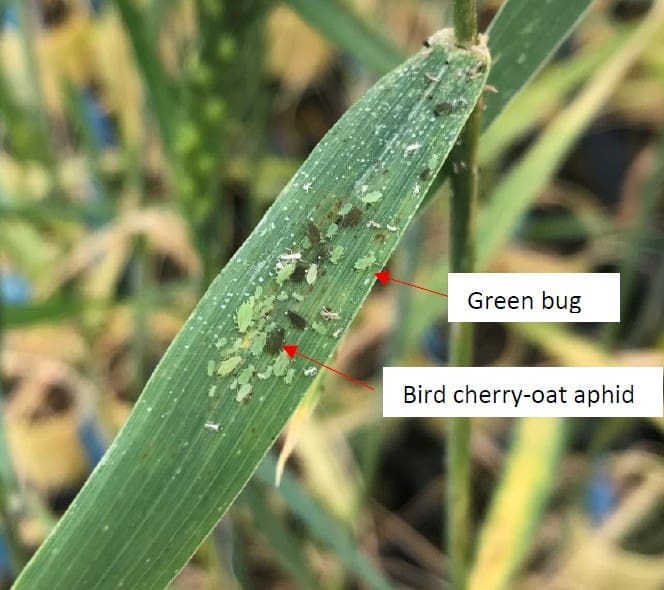
Aphid management:
Aphids have numerous natural enemies such as lady bird beetles, green lacewing larvae, hoverfly, and parasitoid wasps, which are effective in controlling aphid populations without the need for insecticides.
An IPM approach for controlling aphids:
- Field scouting should be conducted regularly. One sample should not represent more than 160 acres, so if the field is larger than a section (160 acres), divide it into one-section blocks and take additional samples. Use a “W” or “U” shaped pattern and combine patterns for irregularly shaped fields. More details about scouting can be found here- https://extension.okstate.edu/fact-sheets/small-grain-aphids-in-oklahoma-and-their-management.html
- Cultural control:
- Controlling volunteer wheat near their fields. Try to have a three-week volunteer-free period prior to the emergence of fall seedings.
- Adjust planting dates. Plant winter wheat as late as possible in northeastern, southwestern and western Colorado. Recommended planting dates have not been determined for southeast Colorado. Plant spring grains as early as possible.
- Planting certified resistant varieties of wheat. For example, Hatcher is resistant to aphids.
- Insecticides should be utilized based on the following guidelines: HPIPM: Russian Wheat Aphid – Bugwoodwiki. These thresholds are typically tailored to Russian wheat aphids and greenbugs, as bird cherry-oat aphids are often found in mixed colonies with them.
Leafhopper Identification
Aster leafhopper (Macrosteles quadrilineatus): Adult aster leafhoppers are olive-green, wedge-shaped insects about 4 mm in length. They’re also called six-spotted leafhoppers because of the three pairs of spots on the tops of their heads (Figure 4). It vectors the aster yellows phytoplasma, which can cause a variety of plant symptoms. Excessive feeding results in yellow discoloration of the leaf, and the characteristic symptoms of “hopper burn.” Hopper burn is often mistaken for drought stress, as the leaves of affected plants begin to turn yellow and will dry out beginning at the leaf tip (Figure 4). Our lab has a population confirmed in New Raymer, and another suspected in Byers.
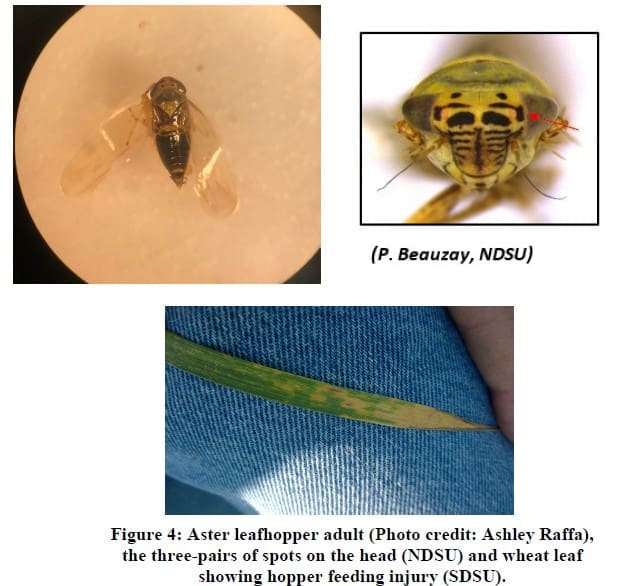
Additional Resources
Michaud, J. P. (2024, June 6). Bird cherry-oat aphid. Facts and Information on Wheat Pests. Retrieved June 20, 2025, from https://entomology.k-state.edu/extension/crop-protection/wheat/bird-cherry.html
Peairs, F. B. (2016, April 1). Russian Wheat Aphid. Aphids in Small Grains. Retrieved June 20, 2025, from https://extension.colostate.edu/docs/pubs/insect/05568.pdf
Small Grain Aphids in Oklahoma and Their Management-https://extension.okstate.edu/fact-sheets/small-grain-aphids-in-oklahoma-and-their-management.html
Aster Leafhoppers Showing up in South Dakota Wheat- https://extension.sdstate.edu/aster-leafhoppers-showing-south-dakota-wheat-
Wheat Diseases
For wheat disease updates by Dr. Robyn Roberts, please see: https://coloradowheat.org/category/news-events/wheat-pest-and-disease-update/
Acknowledgements
We would like to acknowledge the tireless work of CSU researchers and extension agents for reporting pest problems throughout the state.
May 30, 2025
Wheat Stem Sawfly Adult Flight in New Raymer and Orchard
Over the past 13 years, New Raymer and Orchard have been key monitoring sites due to consistently high adult sawfly populations. However, in the last three years, we have observed a significant decline in these populations (highlighted in the red box in the graph). This year, very low numbers of adult sawflies were recorded in New Raymer or Orchard with an average of 50 sawflies per 100 sweeps.
It is important to note that these local declines do not reflect broader state-wide trends. Comprehensive state-wide surveys conducted in 2022 and 2024 (heat maps) indicate some of the most severe sawfly infestations recorded to date. The exception was 2023, which was an unusually wet year, during which sawfly populations dropped significantly across Colorado.
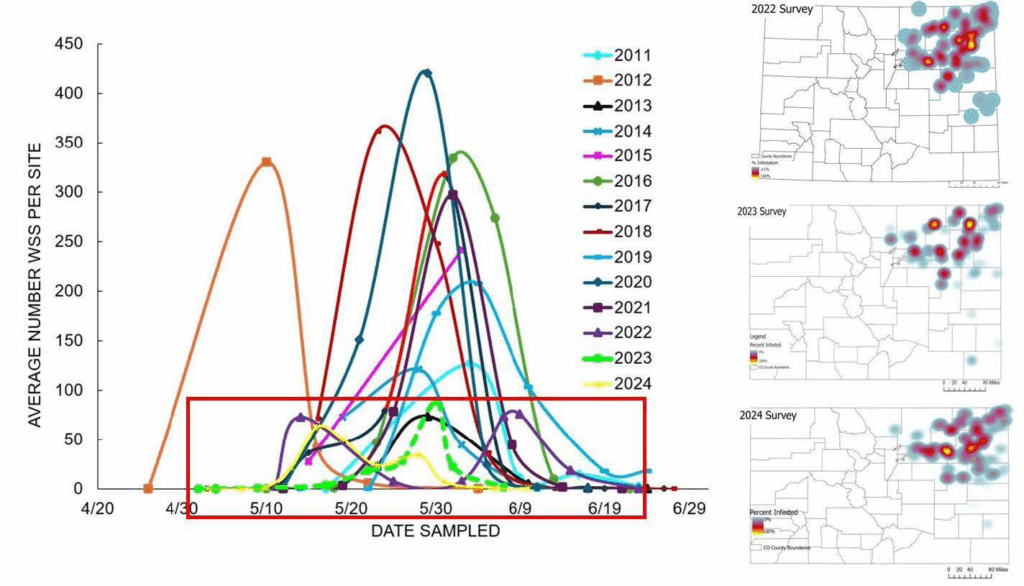
Shift in Sawlfy Activity to Byers
In contrast to the declining sawfly populations in New Raymer and Orchard, we have observed consistently high sawfly activity in Byers. Based on current observations, we believe the sawflies are at peak emergence at this site.
We successfully completed all sawfly infestation experiments at Byers this season, and the preliminary results are promising. Given these favorable conditions, we plan to re-locate our sawfly experiments to Byers for the upcoming year.
Below are some photos of the team transporting two box trucks full of plants to the Byers field site for infestation trials — a big step in adapting our research efforts to shifting population dynamics!
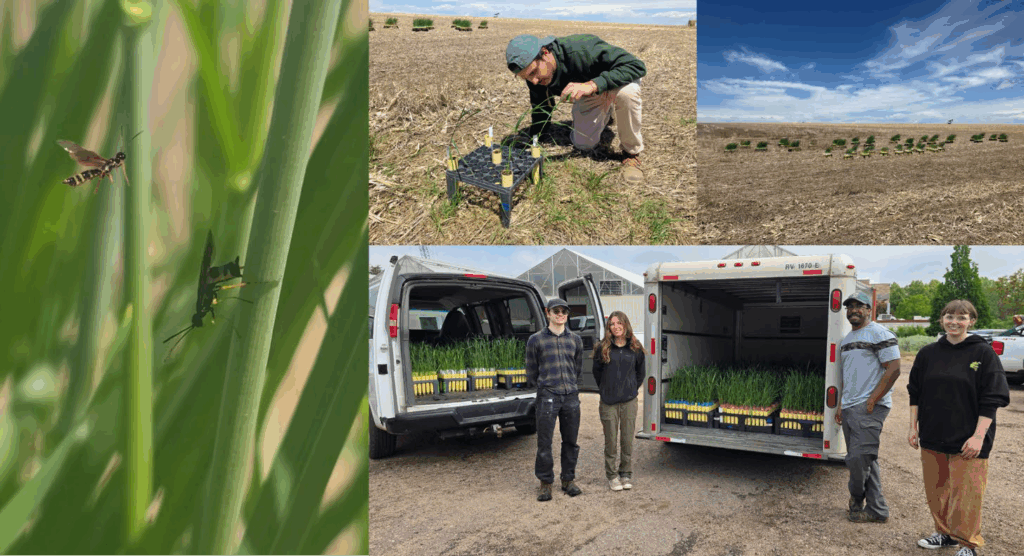
Wheat Field Days
We are looking forward to meeting you all next week at the Wheat Field Days! We have written two articles about wheat stem sawfly in the CSU Crop Testing Making Better Decisions: Colorado Wheat Variety Trials 2025 Technical Report.
Wheat Diseases
For wheat disease updates by Dr. Robyn Roberts, please see:
https://coloradowheat.org/category/news-events/wheat-pest-and-disease-update/
Acknowledgements
We would like to acknowledge the tireless work of CSU researchers and extension agents for reporting pest problems throughout the state.
May 19, 2025
Wheat Stem Sawfly (WSS) Updates
Wheat stem sawflies have started to emerge, and we captured several individuals in New Raymer on May 8th (photo below). Typically, males emerge first, followed by females. Males emerge earlier, allowing them to mate with virgin females, increasing their reproductive fitness.
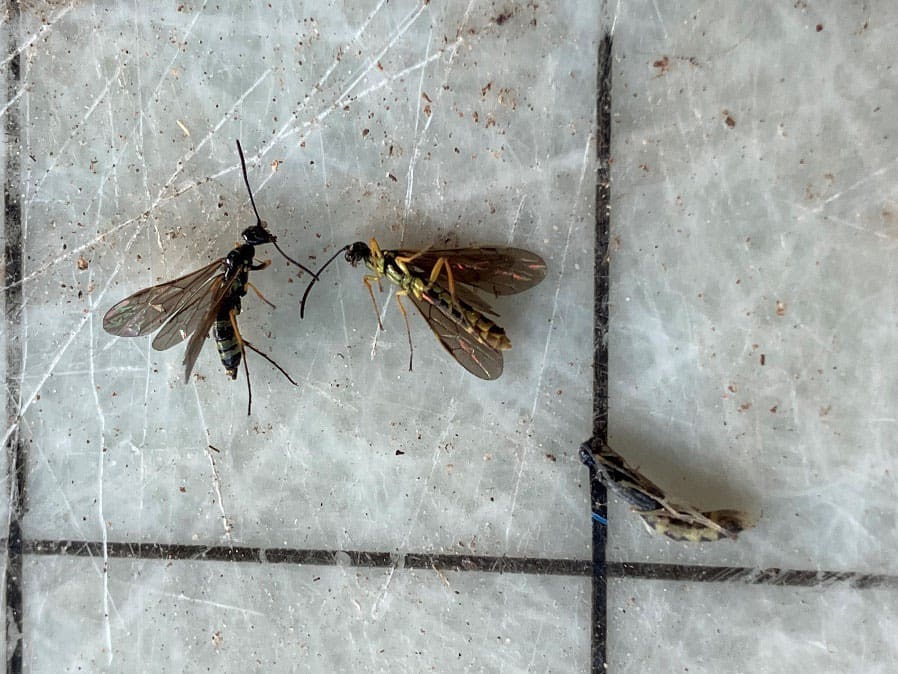
Our degree-day model predicts the following for Weld and nearby counties:
- May 3rd (154DD) for 5% emergence
- May 20th (223DD) for the peak
The cool and wet weather early this week may delay their emergence, but we predict that sawflies will become more abundant later in the week.
Where to Scout:
Wheat fields are particularly vulnerable along edges adjacent to stubble from the previous year. This is because adult wheat stem sawflies emerge from the stubble and move into the current season’s crop. In the area shown below, scouting efforts should be concentrated along the path indicated by the red arrow, where sawfly density is expected to be highest. A sweep net or bug net is used to capture adult sawflies during scouting.
When to Look for Adult Sawflies
Adult sawfly emergence is influenced by weather conditions. Rainfall, strong winds, and cold temperatures can delay or suppress their activity. Therefore, scouting should be prioritized on warm, calm mornings when adults are most likely to be active. Scouting during poor weather may give the false impression that sawflies are absent.
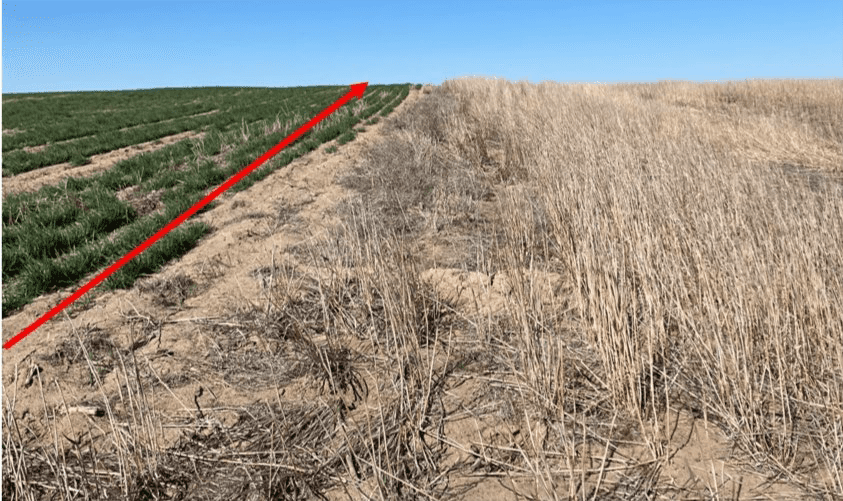
Project Highlight: Wheat Genetics Research Center (Kansas State University) screening wild wheat species for novel sources of resistance
This ongoing project is conducted in collaboration with the Wheat Genetics Research Center at Kansas State University and is funded by CWAC. Wheat lines are grown in cone-tainers in our greenhouse and then exposed to natural wheat stem sawfly infestation in the field. Since sawflies cannot be reared in a laboratory setting, we must transport the plants to infested field sites. This year, we plan to conduct infestations in Akron and Byers due to a significant decline in sawfly populations in the New Raymer and Orchard areas.

Wheat Diseases
For wheat disease updates by Dr. Robyn Roberts, please see:
https://coloradowheat.org/category/news-events/wheat-pest-and-disease-update/
Acknowledgements
We would like to acknowledge the tireless work of CSU researchers and extension agents for reporting pest problems throughout the state.
May 2, 2025
Adam Osterholzer: adam.osterholzer@colostate.edu, 970-222-9568
Dr. Punya Nachappa: Punya.Nachappa@colostate.edu, 785-383-4873
Visit our website at: https://www.csuwheatentomology.com/.
Wheat Stem Sawfly Updates
Every year, we visit wheat fields at Orchard and New Raymer, our historically high sawfly sites, to monitor wheat stem sawfly emergence. In both locations, the sawflies are still in the pupal stage (Figure 1). They are developing adult features, such as legs, eyes, etc. Given this, we expect adult sawfly emergence next week.
Our degree-day model predicts the following for Weld and nearby counties:
- May 3rd (154DD) for 5% emergence
- May 20th (223.3DD) for the peak
- June 1st (287.7DD) for 95% decline
In areas with suspected sawfly populations, growers should monitor the edges of their fields for adults. The insects prefer to fly on calm, warm days. Planting semi-solid wheat varieties can help mitigate losses in areas of high infestation.
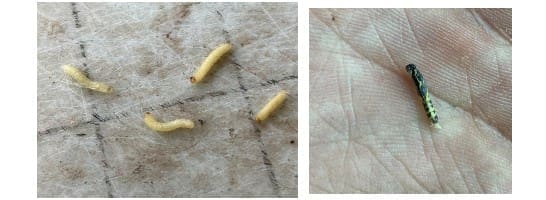
Project Highlight: Beneficial Bug Baler
CSU and the University of Nebraska-Lincoln are undertaking a new project this year with funding from Colorado Wheat Research Foundation (CWRF). We are collaborating with scientists from USDA-ARS to obtain and distribute bales from Nebraska that possess high populations of parasitoid wasps, which are natural enemies of the sawflies. Bales were unfurled at 8 locations in CO-3 in New Raymer, 3 in Orchard and 2 in Byers (Figure 2). We will monitor parasitoid emergence and impacts on the sawfly infestation. This initiative was only possible with the support of our grower cooperators, who have kindly let us use the fields for the experiments!
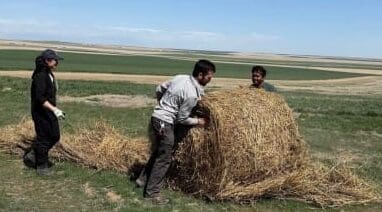
New Region of Concern: South of I-70 Corridor
Our lab conducts an annual statewide survey for sawfly infestation (Figure 3). In 2024, we saw substantial infestation in fields south of Burlington. Growers in this region are advised to scout for sawflies throughout the season. We will continue to monitor the spread and provide updated information. Results will be provided to Colorado wheat and will also be posted at
https://www.csuwheatentomology.com/.

Wheat Diseases
For wheat disease updates by Dr. Robyn Roberts, please see: https://coloradowheat.org/category/news-events/wheat-pest-and-disease-update/
Acknowledgements
We would like to acknowledge the tireless work of CSU researchers and extension agents for reporting pest problems throughout the state.